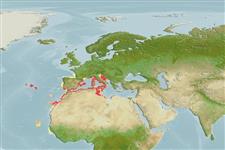>
Anguilliformes (Eels and morays) >
Ophichthidae (Snake eels) > Ophichthinae
Etymology: Apterichtus: From the Greek απτερόν (apteron), without fins, and ίχθύς (ichtus, more correctly written ichthys; masculine), fish..
More on author: Linnaeus.
Environment: milieu / climate zone / depth range / distribution range
Ecologia
marinhas demersal; intervalo de profundidade 0 - 85 m (Ref. 101270). Subtropical; 46°N - 4°S, 32°W - 17°E
Eastern Atlantic: Western and eastern Mediterranean, eastern Atlantic south to Azores, Madeira, and the Canary islands.
Tamanho / Peso / Idade
Maturity: Lm ? range ? - ? cm
Max length : 60.0 cm TL macho/indeterminado; (Ref. 3397)
Descrição suscinta
Chaves de identificação | Morfologia | Morfometria
Vértebras: 132 - 139. This species is distinguished by the following characters: tail 1.6-1.7, head 12-15, and body depth 56-83 in total length; preopercular pores 4 and there are 5 pores in supratemporal canal; teeth conical and uniserial on jaws, becoming biserial on vomer of large specimens, vomerine teeth 8-14; when fresh body ochre in color with numerous small dark brown spots, those spots forming a continuous mid-dorsal band, yellowish on ventral surface; the head with dark brown spots over a pale background, a prominent horizontal white patch beneath and behind the orbit; MVF 52-134, total vertebrae 132-139 (n=6) (Ref. 101270).
Burrows in sand or mud on the continental shelf (Ref. 4455); usually in fine sand (Ref. 101270).
Ciclo de vida ou comportamento de acasalamento
Maturities | Reprodução | Spawnings | Egg(s) | Fecundities | Larvas
McCosker, J.E. and Y. Hibino, 2015. A review of the finless snake eels of the genus Apterichtus (Anguilliformes: Ophichthidae), with the description of five new species. Zootaxa 3941(1):49-78. (Ref. 101270)
Status na Lista Vermelha da UICN (Ref. 130435)
Ameaça para os humanos
Harmless
Uso pelos humanos
Ferramentas
Relatórios especiais
Baixar XML
Fontes da internet
Estimates based on models
Preferred temperature (Ref.
123201): 16.1 - 21, mean 19.1 °C (based on 58 cells).
Índice de diversidade filogenética (Ref.
82804): PD
50 = 0.5000 [Uniqueness, from 0.5 = low to 2.0 = high].
Bayesian length-weight: a=0.00089 (0.00039 - 0.00204), b=3.00 (2.80 - 3.20), in cm total length, based on LWR estimates for this (Sub)family-body shape (Ref.
93245).
Nível Trófico (Ref.
69278): 4.1 ±0.64 se; based on food items.
Resiliência (Ref.
120179): médio(a), tempo mínimo de duplicação da população 1,4 - 4,4 anos (Preliminary K or Fecundity.).
Fishing Vulnerability (Ref.
59153): Moderate vulnerability (44 of 100).
Nutrients (Ref.
124155): Calcium = 48.4 [11.8, 142.6] mg/100g; Iron = 0.973 [0.362, 4.207] mg/100g; Protein = 18.9 [16.6, 21.3] %; Omega3 = 0.313 [0.144, 0.827] g/100g; Selenium = 23.7 [4.7, 65.6] μg/100g; VitaminA = 9.75 [2.86, 32.77] μg/100g; Zinc = 0.574 [0.292, 1.124] mg/100g (wet weight);
